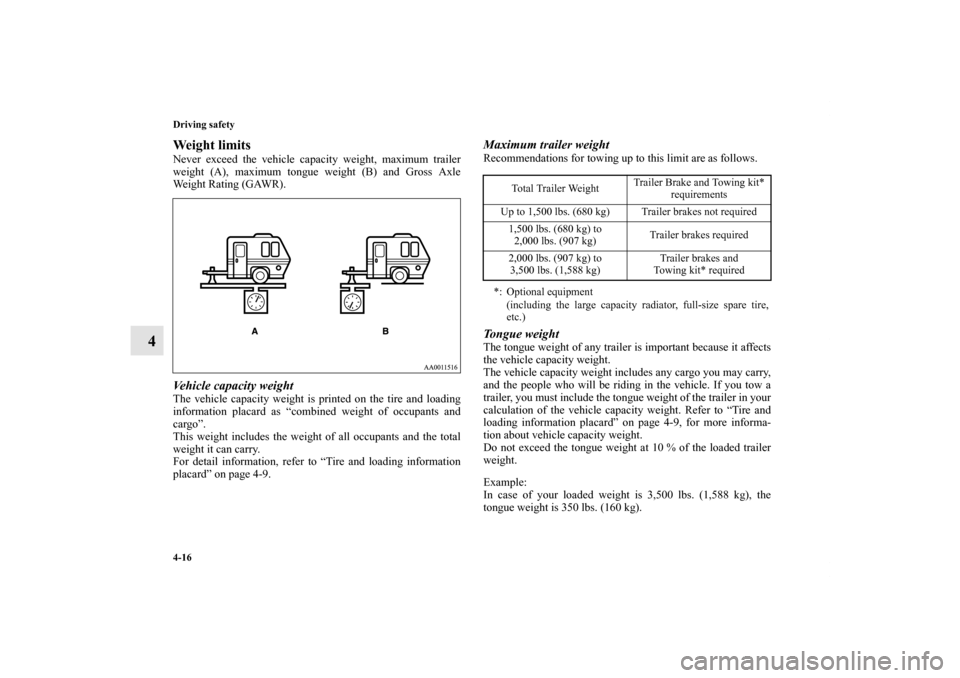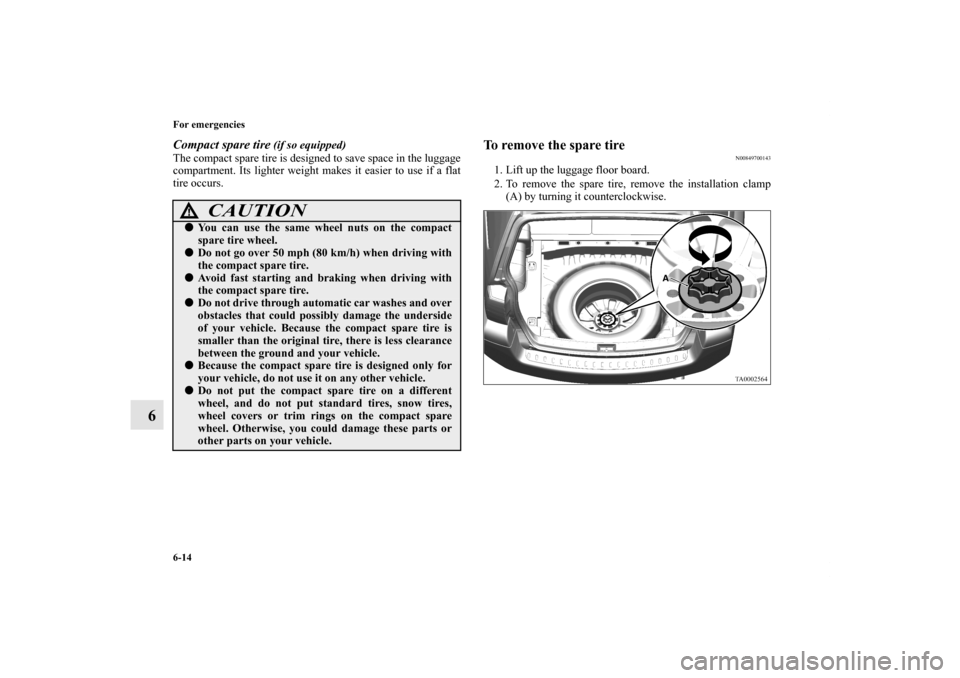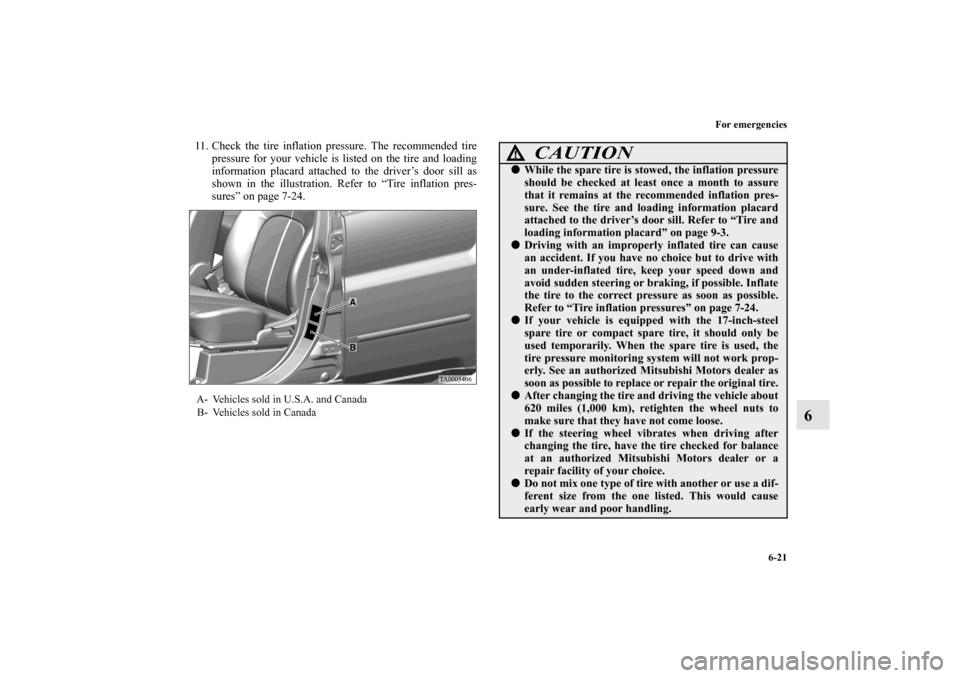Page 303 of 514

4-4 Driving safety
4
Floor mats Defrosters
Check these by selecting the defroster mode, and set the blower
switch on high. You should be able to feel the air blowing
against the windshield.
(Refer to “Defrosting or defogging the windshield and door
windows” on page 5-12, 5-23.)TiresCheck all the tires for heavy tread wear or uneven wear pat-
terns. Look for stones, nails, glass, or other objects stuck in the
tread. Look for any tread cuts or sidewall cracks. Check the
wheel nuts for tightness, and the tires (including spare tire) for
proper pressures. Replace your tires before they are heavily
worn out.
As your vehicle is equipped with a tire pressure monitoring
system, there is a risk of damage to the tire inflation pressure
sensors when the tire is replaced on the rim. Tire replacement
should, therefore, be performed only by an authorized Mitsub-
ishi Motors dealer.LightsHave someone watch while you turn all the exterior lights on
and off. Also check the turn signal indicators and high-beam
indicators on the instrument panel. Fluid leaksCheck the ground under the vehicle after parking overnight, for
fuel, water, oil, or other leaks. Make sure all the fluid levels are
correct. Also, if you can smell fuel, you need to find out why
immediately and have it fixed.
WA R N I N G
!�Keep floor mats clear of the pedals by correctly lay-
ing floor mats that are suitable for the vehicle.
To prevent the floor mats from slipping out position,
securely retain them using the hooks etc.
Note that laying a floor mat over a pedal or laying
one floor mat on top of another can obstruct pedal
operation and lead to a serious accident.
BK0102600US.book 4 ページ 2009年3月30日 月曜日 午後2時2分
Page 315 of 514

4-16 Driving safety
4
Weight limitsNever exceed the vehicle capacity weight, maximum trailer
weight (A), maximum tongue weight (B) and Gross Axle
Weight Rating (GAWR).Vehicle capacity weightThe vehicle capacity weight is printed on the tire and loading
information placard as “combined weight of occupants and
cargo”.
This weight includes the weight of all occupants and the total
weight it can carry.
For detail information, refer to “Tire and loading information
placard” on page 4-9.
Maximum trailer weightRecommendations for towing up to this limit are as follows.Tongue weightThe tongue weight of any trailer is important because it affects
the vehicle capacity weight.
The vehicle capacity weight includes any cargo you may carry,
and the people who will be riding in the vehicle. If you tow a
trailer, you must include the tongue weight of the trailer in your
calculation of the vehicle capacity weight. Refer to “Tire and
loading information placard” on page 4-9, for more informa-
tion about vehicle capacity weight.
Do not exceed the tongue weight at 10 % of the loaded trailer
weight.
Example:
In case of your loaded weight is 3,500 lbs. (1,588 kg), the
tongue weight is 350 lbs. (160 kg).
Total Trailer WeightTrailer Brake and Towing kit*
requirements
Up to 1,500 lbs. (680 kg) Trailer brakes not required
1,500 lbs. (680 kg) to
2,000 lbs. (907 kg)Trailer brakes required
2,000 lbs. (907 kg) to
3,500 lbs. (1,588 kg)Trailer brakes and
Towing kit* required
*: Optional equipment
(including the large capacity radiator, full-size spare tire,
etc.)
BK0102600US.book 16 ページ 2009年3月30日 月曜日 午後2時2分
Page 412 of 514

For emergencies
6-13
6
NOTE�The chocks shown in the illustration do not come with
your vehicle. It is recommended that you purchase chocks
or blocks and keep them in the vehicle for use if needed.
�If chocks or blocks are not available, use stones or any
other objects that are large enough to hold the wheel in
position.
6. Get the jack, bar and wheel nut wrench ready.
Refer to “Tools and jack” on page 6-7.Spare tire information
N00849600269
Check the air pressure of the spare tire frequently and make
sure it is ready for emergency use at any time.
Maintaining the spare tire at the air pressure listed on the tire
and loading information placard will ensure that it can always
be used under any conditions (city/high-speed driving, varying
load weight, etc.).
The spare tire is stored beneath the luggage floor board of the
luggage compartment.
WA R N I N G
!�Tires, including spare tire, degrade over time with
age even when they are not being used.
It is recommended that tires over 6 years generally
be replaced even if damage is not obvious.
CAUTION
!�While the spare tire is stowed, the inflation pressure
should be checked at least once a month to assure
that it remains at the recommended inflation pres-
sure. See the tire and loading information placard
attached to the driver’s door sill. Refer to “Tire and
loading information placard” on page 9-3.�Driving with an improperly inflated tire can cause
an accident. If you have no choice but to drive with
an under-inflated tire, keep your speed down and
avoid sudden steering or braking, if possible. Inflate
the tire to the correct pressure as soon as possible.
Refer to “Tire inflation pressures” on page 7-24.�If your vehicle is equipped with the 17-inch-steel
spare tire or compact spare tire, it should only be
used temporarily. When the spare tire is used, the
tire pressure monitoring system will not work prop-
erly. See an authorized Mitsubishi Motors dealer as
soon as possible to replace or repair the original tire.�You can use the same wheel nuts on the spare tire
wheel.
BK0102600US.book 13 ページ 2009年3月30日 月曜日 午後2時2分
Page 413 of 514

6-14 For emergencies
6
Compact spare tire
(if so equipped)
The compact spare tire is designed to save space in the luggage
compartment. Its lighter weight makes it easier to use if a flat
tire occurs.
To remove the spare tire
N00849700143
1. Lift up the luggage floor board.
2. To remove the spare tire, remove the installation clamp
(A) by turning it counterclockwise.
CAUTION
!�You can use the same wheel nuts on the compact
spare tire wheel.�Do not go over 50 mph (80 km/h) when driving with
the compact spare tire.�Avoid fast starting and braking when driving with
the compact spare tire. �Do not drive through automatic car washes and over
obstacles that could possibly damage the underside
of your vehicle. Because the compact spare tire is
smaller than the original tire, there is less clearance
between the ground and your vehicle. �Because the compact spare tire is designed only for
your vehicle, do not use it on any other vehicle. �Do not put the compact spare tire on a different
wheel, and do not put standard tires, snow tires,
wheel covers or trim rings on the compact spare
wheel. Otherwise, you could damage these parts or
other parts on your vehicle.
BK0102600US.book 14 ページ 2009年3月30日 月曜日 午後2時2分
Page 414 of 514
For emergencies
6-15
6
NOTE�Put the spare tire under the vehicle body near the jack.
This makes it safer if the jack slips out of position.
To change a tire
N00849800359
1. Loosen the wheel nuts with the wheel nut wrench. Do not
remove the wheel nuts yet.
BK0102600US.book 15 ページ 2009年3月30日 月曜日 午後2時2分
Page 417 of 514
6-18 For emergencies
6
6. Clean out any mud, etc. on the hub surface (F), hub bolts
(G) or in the installation holes (H) in the wheel, and then
mount the spare tire.
WA R N I N G
!�Mount the spare wheel with the valve stem (I) facing
outboard. If you cannot see the valve stem (I), you
have installed the wheel backwards.
Operating the vehicle with the spare wheel installed
backwards can cause vehicle damage and result in
an accident.
BK0102600US.book 18 ページ 2009年3月30日 月曜日 午後2時2分
Page 418 of 514
For emergencies
6-19
6
7. On aluminum wheels, temporarily tighten the wheel nuts
(flange nuts) until their flange section comes in contact
with the wheel and it is no longer loose.On steel wheel (spare wheel), install the wheel nuts with
their tapered ends facing inward, then tighten by hand
until the wheel is no longer loose.
NOTE�Flange nuts can be temporarily used on the steel wheel
(spare wheel), but return them to the original wheel and
tire as soon as possible.
�If all four wheels are changed to steel wheels, use tapered
nuts.
Aluminum wheels
CAUTION
!�Never apply oil to either the wheel bolts or the nuts
or they will tighten too much.Steel wheel (spare wheel)
BK0102600US.book 19 ページ 2009年3月30日 月曜日 午後2時2分
Page 420 of 514

For emergencies
6-21
6
11. Check the tire inflation pressure. The recommended tire
pressure for your vehicle is listed on the tire and loading
information placard attached to the driver’s door sill as
shown in the illustration. Refer to “Tire inflation pres-
sures” on page 7-24.A- Vehicles sold in U.S.A. and Canada
B- Vehicles sold in Canada
CAUTION
!�While the spare tire is stowed, the inflation pressure
should be checked at least once a month to assure
that it remains at the recommended inflation pres-
sure. See the tire and loading information placard
attached to the driver’s door sill. Refer to “Tire and
loading information placard” on page 9-3.�Driving with an improperly inflated tire can cause
an accident. If you have no choice but to drive with
an under-inflated tire, keep your speed down and
avoid sudden steering or braking, if possible. Inflate
the tire to the correct pressure as soon as possible.
Refer to “Tire inflation pressures” on page 7-24.�If your vehicle is equipped with the 17-inch-steel
spare tire or compact spare tire, it should only be
used temporarily. When the spare tire is used, the
tire pressure monitoring system will not work prop-
erly. See an authorized Mitsubishi Motors dealer as
soon as possible to replace or repair the original tire.�After changing the tire and driving the vehicle about
620 miles (1,000 km), retighten the wheel nuts to
make sure that they have not come loose.�If the steering wheel vibrates when driving after
changing the tire, have the tire checked for balance
at an authorized Mitsubishi Motors dealer or a
repair facility of your choice.�Do not mix one type of tire with another or use a dif-
ferent size from the one listed. This would cause
early wear and poor handling.
BK0102600US.book 21 ページ 2009年3月30日 月曜日 午後2時2分